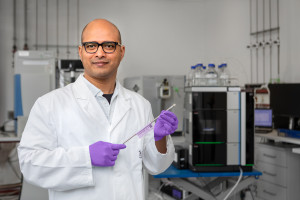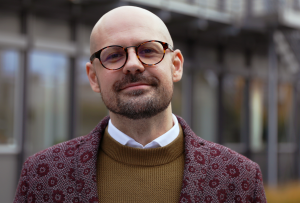Dortmund, 15th October 2024
On September 27, 2024, the city of Dortmund was transformed into a meeting place for the curious and science enthusiasts. Over 2,500 visitors participated in experiments, science shows and lectures throughout the city at the first Science Night in Dortmund. ISAS was also part of this special premiere: together with the storyLab kiU of Fachochschule Dortmund, University of Applied Sciences and Arts, researchers presented an immersive 3D experience in the Dortmunder U. Visitors were able to immerse themselves in "The Secret World of the Immune System" - specifically in the context of a heart attack.
The immersive space of storyLab kiU, located in the foyer of the Dortmunder U, measures four by four meters. Anyone who enters the room will step into new worlds involving all their senses with the help of high-performance projectors and a 32-channel sound system. Normally, these are based on works of art from the collections of Dortmund's museums - but at the Science Night, visitors were taken on a journey into the smallest structures of a heart after a heart attack. Visitors were able to marvel at real microscope images from ISAS, including a 3D reconstruction of a mouse heart and immune cells that migrate into the damaged tissue after a heart attack. These cells, including macrophages for example, are actually supposed to support healing. However, in the "clean-up frenzy" after the heart attack, they cause scarring in the heart muscle structure. This can have a long-term negative impact on heart function.
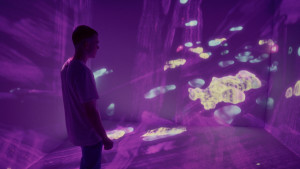
In the immersive space, visitors can experience immune cells in heart tissue up close. Here you can see how the macrophages (yellow) slowly move towards their target cells (pink). A special feature of the room: a tracking system records the position of the person so that the optical perspective adjusts accordingly. The projection therefore always appears three-dimensional to the viewer.
© storyLab kiU
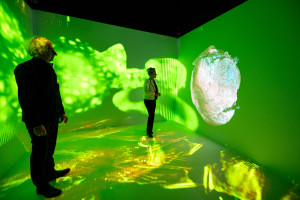
Ina Brandes, Minister for Culture and Science of the state of North Rhine-Westphalia, also attended the Science Night and got a first-hand impression of the immersive experience. Accompanied by Harald Opel, artistic director of storyLab kiU, she watches an image of an infarcted heart taken using a light sheet fluorescence microscope. The green rays in the background are reminiscent of the microscope's laser.
© Stadt Dortmund / Roland Baege
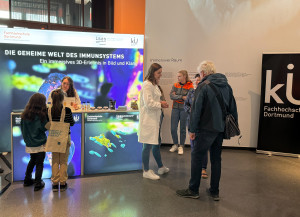
Researchers, recognisable by their lab coats, were on hand to answer questions at the joint stand of Fachhochschule Dortmund, University of Applied Sciences and Arts and ISAS. The photo shows two doctoral students from the research group, Flora Weber and Lara Janz. Weber (left) is explaining the optical clearing process. In this process developed by Prof Dr Anika Grüneboom, scientists around the world use the natural flavouring agent cinnamic acid ethyl ester to make organic samples transparent so that they can then be examined under a microscope.
© ISAS
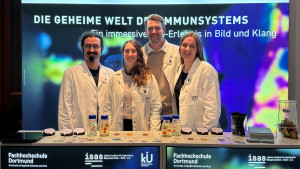
Dr Ali Ata Tuz, Flora Weber, Dr Malte Roeßing and Lara Janz (from left to right) are at the joint stand of Fachhochschule Dortmund, University of Applied Sciences and Arts and ISAS to answer questions about the immersive experience.
© ISAS
Art meets immunology
The microscope images on which the immersive experience is built come from the Bioimaging research group at ISAS. The scientists use various microscopic methods, including light sheet fluorescence microscopy (see infobox), to better understand the immune response to a heart attack and the resulting consequential damage. In the long term, they hope this will pave the way for new heart attack therapies. "This is the first time we have shown our research data in an artistic context," reports Prof Dr Anika Grüneboom, head of the research group. This required intensive preparation: The artists and scientists worked together for several months to bring the research from the ISAS laboratory to the Dortmunder U. How fast do the macrophages move? Where is there room for artistic freedom? And what about the sound design? Grüneboom thinks the work was worthwhile: "The cooperation with storyLab kiU shows that science can fascinate children and adults and still amazes even us researchers.”
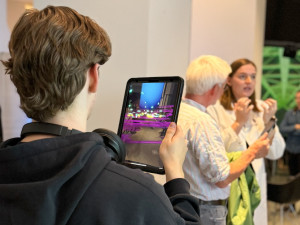
For the Science Night, the storyLab kiU team has prepared tablets that project the immune cells into the foyer of the Dortmunder U in greatly enlarged form using augmented reality. The macrophages (yellow) move with the visitors through the muscle tissue (purple). In the background, Lara Janz, PhD student at ISAS, explains the images to a visitor.
© ISAS
Light sheet fluorescence microscopy
One of the imaging techniques used by the Bioimaging research group is fluorescence microscopy. Fluorescence describes the property of substances to absorb short-wave light and re-emit it at a longer wavelength. In order to recognise certain structures under the microscope, researchers stain samples with target structure-specific fluorescent dyes that have these properties. This form of light microscopy includes light sheet fluorescence microscopy. Here, a laser illuminates only a thin layer of the sample, for example a heart, without destroying it. From the many individual images of the tissue layers, researchers later create a 3D model of the entire sample on the computer.
Researchers in dialogue
While some visitors gazed at the images in the immersive space, others took the opportunity to engage in dialogue with the researchers and designers outside. At the joint FH Dortmund and ISAS stand, curious guests were also able to project the immune cells into the centre of the foyer of the Dortmunder U using tablets.
“The dialogue with the visitors was very rewarding for us researchers too. It gave us new perspectives on our work, which we will take back to ISAS," summarises Dr Malte Roeßing, research associate in the Bioimaging working group. The biologist was not only in dialogue with the visitors. In the kiU talk "Fact and Fiction" in the evening, he discussed the interplay between art and science with Lennart Oberscheidt and Tobias Bieseke from storyLab kiU.
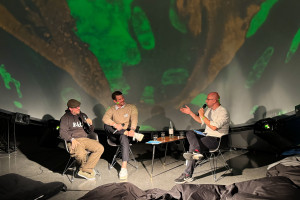
Hosted by Tobias Bieseke (right), Lennart Oberscheidt (both storyLab kiU, left) and Dr Malte Roeßing, research associate in the Bioimaging research group at ISAS, discussed the interplay between art and science. In the panel discussion, the three talk about interdisciplinary collaboration in the project, the role of aesthetics in biomedical imaging and the boundaries of fact and fiction in science.
© ISAS







